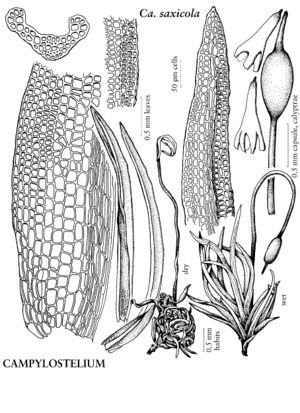Difference between revisions of "Campylostelium saxicola"
Bryol. Europ. 2: 27. 1846,.
FNA>Volume Importer |
FNA>Volume Importer |
||
| Line 25: | Line 25: | ||
|elevation=moderate elevations (400-1300 m) | |elevation=moderate elevations (400-1300 m) | ||
|distribution=P.E.I.;Que.;Ala.;Ark.;D.C.;Ind.;Ky.;Mass.;N.H.;N.J.;N.Y.;N.C.;Ohio;S.C.;Tenn.;Va.;Wash.;Europe. | |distribution=P.E.I.;Que.;Ala.;Ark.;D.C.;Ind.;Ky.;Mass.;N.H.;N.J.;N.Y.;N.C.;Ohio;S.C.;Tenn.;Va.;Wash.;Europe. | ||
| − | |discussion=<p>Campylostelium saxicola is a tiny moss with glossy, crisped, or sometimes circinate leaves; it grows on shaded boulders in forests over most of its range but in rock shelters in the southern portion. Campylostelium saxicola is wide-spread in the flora area but infrequently collected due to its inconspicuous nature. Its small delicate stature, smooth calyptra, and usually flexuous-curved seta distinguish it from Ptychomitrium.</p> | + | |discussion=<p><i>Campylostelium saxicola</i> is a tiny moss with glossy, crisped, or sometimes circinate leaves; it grows on shaded boulders in forests over most of its range but in rock shelters in the southern portion. <i>Campylostelium saxicola</i> is wide-spread in the flora area but infrequently collected due to its inconspicuous nature. Its small delicate stature, smooth calyptra, and usually flexuous-curved seta distinguish it from <i>Ptychomitrium</i>.</p> |
|tables= | |tables= | ||
|references= | |references= | ||
| Line 49: | Line 49: | ||
|publication year= | |publication year= | ||
|special status= | |special status= | ||
| − | |source xml=https://jpend@bitbucket.org/aafc-mbb/fna-data-curation.git/src/ | + | |source xml=https://jpend@bitbucket.org/aafc-mbb/fna-data-curation.git/src/8f726806613d60c220dc4493de13607dd3150896/coarse_grained_fna_xml/V27/V27_418.xml |
|genus=Campylostelium | |genus=Campylostelium | ||
|species=Campylostelium saxicola | |species=Campylostelium saxicola | ||
Revision as of 16:54, 18 September 2019
Plants glossy. Leaves 2–3 mm, often circinately curled when dry, margins entire, erect; apices acute, subcucullate. Seta 5–7 mm, twisted below the capsule and often flexuous when dry, often recurved when wet. Capsule 1–1.2 mm, smooth or slightly wrinkled when dry; operculum red proximally, 0.5–0.7 mm; peristome teeth red. Calyptra 0.7 mm, mostly shallowly lobed proximally. Spores 8–10 µm.
Phenology: Capsules mature Oct–May.
Habitat: Forests or openings on acidic sandstone boulders and cliffs, and sandstone rock shelters
Elevation: moderate elevations (400-1300 m)
Distribution

P.E.I., Que., Ala., Ark., D.C., Ind., Ky., Mass., N.H., N.J., N.Y., N.C., Ohio, S.C., Tenn., Va., Wash., Europe.
Discussion
Campylostelium saxicola is a tiny moss with glossy, crisped, or sometimes circinate leaves; it grows on shaded boulders in forests over most of its range but in rock shelters in the southern portion. Campylostelium saxicola is wide-spread in the flora area but infrequently collected due to its inconspicuous nature. Its small delicate stature, smooth calyptra, and usually flexuous-curved seta distinguish it from Ptychomitrium.
Selected References
None.
